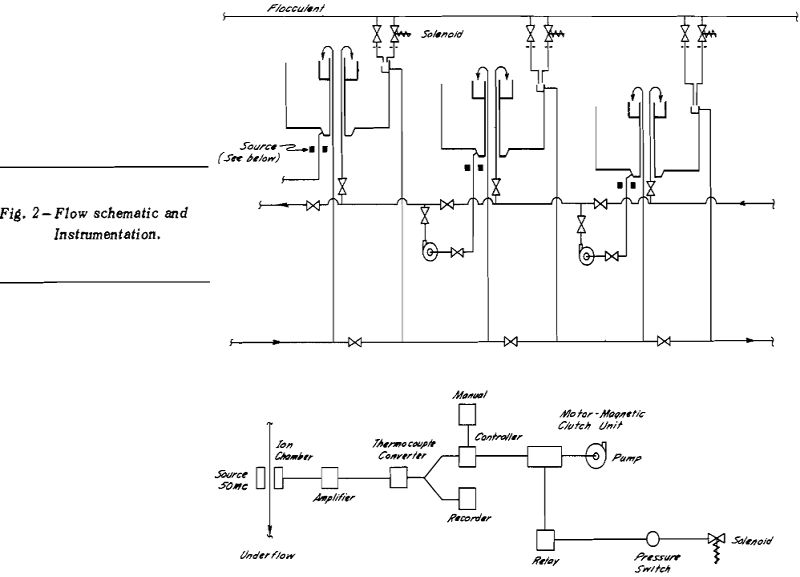Table of Contents
The use of a series of thickeners for washing of the slime fraction of a leached ore is not uncommon in the uranium industry; however, few ore processing mills have used a thickener circuit for washing leached total ore. The common practice is to wash the sand fraction in classifiers and the slime fraction only in thickeners.
General Description of Circuit
The circuit utilized consists of eight wooden fir tanks, 60-ft diam by 12-ft deep, set in a line and staggered in elevation by approximately 3 ft. The washing water flows through the thickeners by gravity, while the ore pulp is pumped uphill from thickener to thickener. Adequate piping and pumping capacity are available so that any of the thickeners can be bypassed in the circuit.
The drive mechanisms used for these thickeners are driven by 3-hp motors. The mechanism is of the non-lifting type, and a torque arm is employed in the drive to indicate overloads. A pointer is attached to the torque arm and the load on the thickener is indicated on a dial attached to the drive.
The centerwell of the thickeners are approximately 10 ft in diam and 4-ft deep with a wooden launder attached to the inside circumference of the well. The pulp feed to the thickener is fed into the launder which then overflows, distributing the feed around the entire centerwell.
Control of Circuit
To achieve maximum washing efficiencies in a thickener washing circuit, it is of course necessary to achieve maximum thickener underflow densities. The normal operating underflow specific gravity of the total ore thickeners at Uravan is 1.53 to 1.55 with an ore that has a true density of about 2.6. The underflow at these conditions contains approximately 56 to 58 pct solids. The thickeners have been operated consistently at 60 to 62 pct solids in this circuit; however, at these conditions there is a tendency for the thickeners to backlog or build up excessive loads and islands, thus requiring considerably more operator attention.

Flocculation
A phenomena which occurs in a thickener used for washing total ore, that is somewhat different than when only slimes are fed, is that the coarse ore sand fraction will fall directly to the bottom of the thickener or ducks nest. Slimes will distribute throughout the entire area of the thickener. An important feature in attaining good operation is to maintain a uniform settling rate of the slime fraction or a classification will occur and the thickener underflow will alternately consist of slimes and then sands.
The flocculent is prepared at a strength of about 0.10 wt pct. This solution is fed from a head tank through a piping manifold to the thickeners. It is then introduced into the overflow of each thickener through pipe cap orifices. The solution is further diluted, by the thickener overflow, to about 5 ppm and then fed directly into the centerwell of the following thickener.
The pulp feed to the thickener is introduced in the launder previously mentioned, which in turn overflows gently into the centerwell. This method of feeding results in a gentle mixing of the pulp feed and flocculent solution in the centerwell. There the flocs of slimes form and the sand falls freely in an evenly distributed pattern.
Two methods of automatic control are used to regulate the quantity of flocculent fed to the thickeners. The primary method, which is used on the majority of the thickeners, is based upon the rate of pulp feed to the thickener.
The second automatic method employed for adding flocculent is utilized on the No. 8 thickener which is fed with a constant speed pump from the leach circuit. This system utilizes a method of automatically monitoring the slime depth in the thickener and using this measurement to actuate a solenoid valve on the flocculent feed.
It may take as long as 8 hr to eliminate a large surge in a single thickener. If the surge occurs in No. 8 thickener, more than two days are required for the surge to pass through the system. The magnitude of the surge normally decreases as it moves up the circuit.
